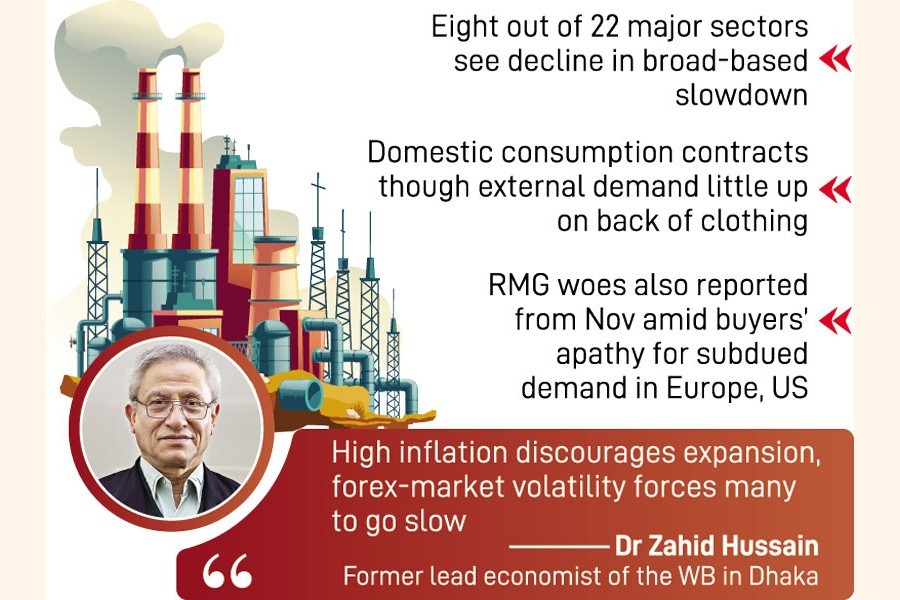Manufacturing contraction in large-scale and medium industries amid high inflation at home and abroad, coupled with various other adversities, raises worry about economic slowdown.
September data available last week showed such manufacturing shrank over 2.0 per cent compared to a year earlier and over 4.0 per cent compared to last August.
Sources say the concern about economic slowdown is accentuated especially by the volatility on the foreign-exchange market and the highest-ever costs of raw materials and other inputs globally, which all affect trade and consumption.
The main contributors to the sluggishness were food (down by 8.25 pc), beverage (down by 18 pc), textiles (down by 3.6 pc) chemical products (down by 50 pc) and apparel (down by 2.2 pc), according to the data released by Bangladesh Bureau of Statistics or BBS, the country's national statistical organisation.
Bangladesh's major industrial-production growth moderated below 4.0 per cent year on year in July, the first month of the current fiscal year (FY 2022-23). Usually the growth remains in double-digit territory.
The high-frequency data depict dearth-driven domestic consumption contraction while the external demand was slightly up as apparel and textiles grew despite a global crunch stemming from the Ukraine war in lockstep with the global pandemic.
The production estimation for medium and large-scale industries was made using the new base year 2015-16.
Eight major sectors out of 22 see decline in broad-based slowdown.
In the fiscal year 2021-22, the manufacturing sector had nearly 23-percent share in the gross domestic product or GDP, and large-scale manufacturing segment accounted for nearly 11 per cent. Small, medium and micro had nearly 8.0-percent contribution. The cottage industry had around 4.0-percent share.
The apparel sector, accounting for more than 80 per cent of export-market share, shifted into almost a reverse trend, shrinking over 2.0 per cent in September over a month earlier in August. In August, it rose over 43 per cent.
Beverage sector also saw a reversal in September.
However, paper and related industry grew by 93 per cent in September over its corresponding period a year before.
The printing and linkage industry surged 16 per cent in September. And motor vehicles, trailer and semi-trailer industry expanded 25 per cent in September.
Economists view that higher inflation usually discourages investment and expansion, leading to sluggish growth.
Dr Zahid Hussain, former lead economist of the World Bank, explains the factors that slow the pace of production and consumption in an economy. "Higher inflation usually discourages expansion while the volatility on the forex market forced many to go slow," he told the FE.
Syed Nazrul Islam, first vice president of BGMEA, says the September production was poor. "We had received huge orders in March and April and production was good until August last."
Production reflects after three to four months.
"Actually, our bad time started in November with the buyers showing less interest following poor demand for clothing in Europe and the USA," Mr Islam told the FE, indicating the impacts of steep inflation in the export-destination countries amid the global dearth.
Aameir Alihussain, managing director of BSRM Group--the largest rod maker in Bangladesh-says production is okay but sales dropped in recent months as many shy away from making investment in the construction sector.
"Actually, our production was huge up to July as there was adequate demand for our rods, but now it slowed down significantly."
Mr Aameir also points out load-shedding and lower pressure of gas as dampers on the construction-backward-linkage industry.


